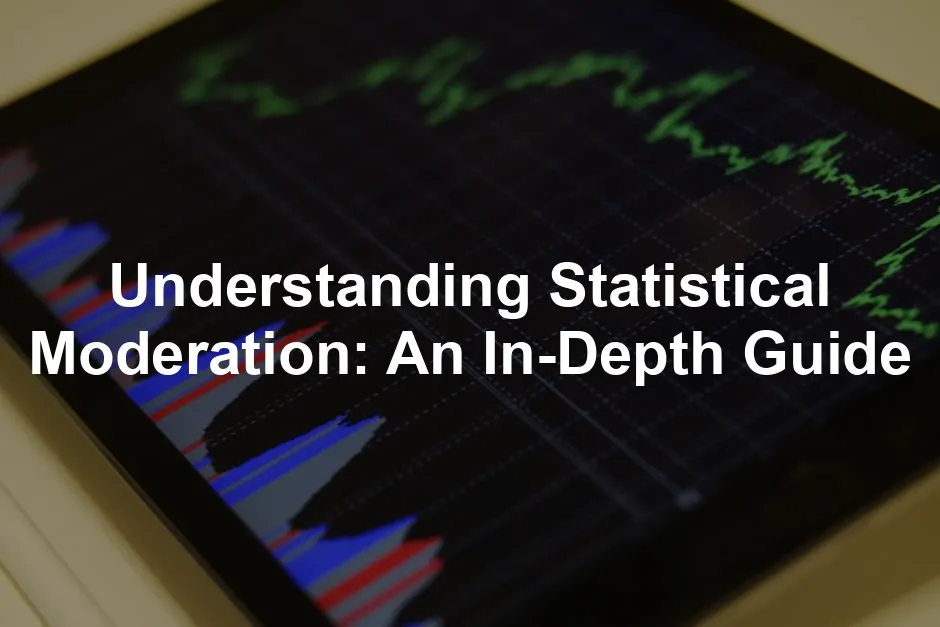Introduction
Statistical moderation is like adding a pinch of spice to your data analysis stew—it enhances the flavor! But what exactly does it mean? In research, moderation occurs when the relationship between two variables hinges on a third variable, known as the moderator variable. Imagine being in a relationship where the dynamics change based on a friend’s opinion—this is similar to how moderator variables work in statistical terms.
So, why should researchers care about moderation? Understanding moderator variables is crucial for painting a complete picture of how variables interact with one another. They help clarify under what circumstances one variable influences another. For instance, a study might find that the impact of exercise on happiness varies depending on an individual’s social support level. In this case, social support serves as a moderator.
Throughout this article, we’ll unpack the concept of statistical moderation in detail. We’ll define what moderator variables are, distinguish them from mediators, and delve into the importance of moderation analysis in various fields. By the end, you’ll be equipped with insights to apply moderation analysis effectively in your own research endeavors.

What is Statistical Moderation?
Definition of Moderation
Moderation in statistical terms refers to the phenomenon where the relationship between an independent variable (X) and a dependent variable (Y) is influenced by a third variable, known as the moderator (M). Think of the moderator as a referee in a sports game, determining how the players interact. For example, if we consider the relationship between study time (X) and exam scores (Y), the effect might differ based on the student’s motivation level (M). Here, motivation acts as a moderator.
It’s essential to distinguish moderation from mediation. While a moderator alters the strength or direction of the relationship between X and Y, a mediator explains the process behind that relationship. In other words, a mediator tells you how X influences Y, while a moderator tells you when or for whom that influence occurs.

Importance of Moderation Analysis
Why is moderation analysis vital for robust statistical modeling? For starters, it helps researchers uncover the complexities of relationships between variables. Without considering moderation, you might overlook critical factors that can change the outcome of your analysis.
Take psychological studies, for instance. Researchers often explore how stress affects mental health. However, the impact of stress might vary depending on social support levels. By conducting moderation analysis, they can identify these nuances and draw more accurate conclusions.
If you’re looking to dive deeper into statistical concepts, you might want to check out Statistics for Dummies. It’s a great resource for demystifying the world of statistics!

In the realm of business analytics, understanding customer behavior is paramount. For example, a company’s marketing strategy may have different effects based on consumer demographics. By incorporating moderation analysis, businesses can tailor their strategies for specific audience segments, optimizing their marketing efforts.
In summary, moderation analysis is an indispensable tool in research. It allows for a more nuanced understanding of relationships between variables, leading to better-informed decisions and insights. Whether you’re in psychology, business, or any other field, recognizing the role of moderator variables can significantly enhance your analytical prowess.

Key Concepts and Terminology
Independent, Dependent, and Moderator Variables
Understanding the basic building blocks of statistical analysis is crucial. Let’s break it down!
Independent Variable (IV): This is the variable that you manipulate or control in your study. Think of it as the cause. For example, suppose you’re studying how different amounts of study time impact exam scores. Here, study time is your independent variable.
Dependent Variable (DV): This variable responds to changes in the independent variable. It’s the effect or outcome you’re measuring. Using the previous example, exam scores would be the dependent variable, as they depend on how much time students studied.
Moderator Variable: Enter the moderator, the unsung hero! A moderator variable influences the strength or direction of the relationship between the independent and dependent variables. For instance, if you consider student motivation as a moderator in our study time and exam scores scenario, the effect of study time on exam scores may vary based on how motivated the student is. So, if you’re low on motivation, no amount of study time might help!

Interaction Effects
Now, let’s chat about interaction effects—sounds fancy, right? In regression analysis, an interaction effect occurs when the effect of one independent variable on the dependent variable differs depending on the level of another variable.
Imagine you’re analyzing how the relationship between study time and exam scores changes at different levels of motivation. This is where the interaction term comes into play. It’s calculated by multiplying the independent variable (study time) by the moderator (motivation). Including this term in your regression model allows you to see if the relationship between study time and exam scores is stronger or weaker based on motivation levels. It’s like adding an extra layer of depth to your analysis—a little sprinkle of magic!

Types of Moderator Variables
Moderators can be categorized into two types: categorical and continuous.
Categorical Moderators: These are variables that can be divided into distinct groups or categories. For instance, consider gender as a moderator in a study examining how social media usage affects feelings of loneliness. You might find that females and males experience this relationship differently. Here, gender is a categorical moderator.
Continuous Moderators: On the other hand, continuous moderators are measured on a scale and can take on any value. For example, age can serve as a continuous moderator in a study investigating the relationship between physical activity and overall health. The impact of physical activity on health might vary for different age groups, showcasing how the relationship shifts across the continuous spectrum.
Understanding these types of moderators helps you choose the right variables for analysis and interpret your findings more effectively. The implications of choosing the right moderator type can significantly shape your results and insights. So, equip yourself with this knowledge, and you’ll be ready to tackle moderation analysis like a pro!

Running the Regression Analysis
Fitting a regression model with an interaction term is essential for moderation analysis. Here’s a step-by-step guide to get you started:
- Identify Your Variables: First, you need to know your independent variable (X), dependent variable (Y), and moderator (M). For example, let’s say we want to examine how study time affects exam scores, with motivation as the moderator.
- Compute the Interaction Term: Multiply your independent variable (X) by your moderator (M) to create the interaction term (XM). In our example, this means multiplying study time by motivation level.
- Prepare Your Data: Make sure your dataset includes X, Y, M, and XM. Clean your data by checking for missing values or outliers, ensuring that your data is ready for analysis.
- Run the Regression Model: Fit a regression model using your data. In R, for instance, you’d use the following command:
model <- lm(Y ~ X + M + XM, data = your_data)
This equation includes the main effects of X and M, along with the interaction term XM. - Check Model Summary: After fitting the model, check the summary output. Look for the coefficients associated with X, M, and XM. A significant p-value for the XM coefficient suggests there’s a moderation effect.
- Evaluate Model Fit: Assess the overall fit of your model using R-squared and Adjusted R-squared values. A higher value indicates a better fit. Also, check diagnostics for residuals to ensure that they meet the assumptions of regression analysis.

By following these steps, you’ll successfully fit a regression model that incorporates an interaction term, setting the stage for interpreting the results.
Interpreting Results
Interpreting the results of your regression analysis is crucial for understanding moderation. Here’s how to break it down:
- Significance of the Interaction Term: Start by examining the p-value of the interaction term (XM). If it’s less than 0.05, congratulations! This indicates that your moderator (M) significantly influences the relationship between your independent variable (X) and dependent variable (Y).
- Understanding Coefficients: The coefficient of the interaction term shows how the effect of X on Y changes depending on the level of M. A positive coefficient suggests that as the moderator increases, the relationship between X and Y strengthens. Conversely, a negative coefficient indicates that the relationship weakens.
- Simple Slopes Analysis: To grasp the moderation effect better, perform a simple slopes analysis. This involves calculating the effect of X on Y at different values of M (e.g., mean, one standard deviation above, and one standard deviation below). This analysis highlights how the impact of X varies across different levels of M.
- Visualizing Interaction Effects: Plotting the interaction effects can be incredibly insightful. Use software like R or Python to create interaction plots. This visual representation helps clarify how the relationship between X and Y shifts at various levels of M.
- Effect Size: Consider the effect size of the interaction term. A large effect size suggests that the moderation effect is practically significant, meaning it’s not just statistically significant but also meaningful in a real-world context.
- Conditional Effects: Finally, analyze the conditional effects of X on Y at specific values of M. This will provide a nuanced understanding of the conditions under which X influences Y, and it will help you communicate your findings clearly.

By following these steps, you’ll be able to interpret the significance of the interaction term and gain valuable insights regarding the moderation effect in your analysis.
Best Practices
When conducting moderation analysis, think of it as hosting a dinner party. You want everything to flow smoothly, right? Here are some best practices that will help you serve up a delicious analysis:
- Center Your Variables: Before creating interaction terms, center your continuous variables. This means subtracting the mean from each value. It reduces multicollinearity and makes interpretation clearer. Think of it as adjusting the flavors in your dish so that they complement each other instead of overpowering!
- Check Assumptions: Ensure your data meets the assumptions of linearity and independence. Just like you wouldn’t want a rogue onion ruining your salad, you don’t want violations of assumptions spoiling your analysis. Test for multicollinearity, and ensure that residuals are homoscedastic.
- Use Appropriate Software: R and Python are fantastic tools for moderation analysis. R has specific packages like
lm()andinteractionsthat simplify the process, while Python offers libraries such asstatsmodels. Choose your software based on your comfort level and the specific requirements of your analysis. - Interpret with Care: When you interpret the results, remember to focus on the interaction term. A significant interaction suggests that the effect of your independent variable varies depending on the level of the moderator. Use simple slopes analysis to illustrate how this relationship changes under different conditions.
- Visualize Your Results: Don’t just present numbers—create interaction plots! Visualizing the moderation effects makes it easier for your audience to grasp complex relationships. Think of it as putting a cherry on top of your dessert; it makes everything more appealing!
- Report Effect Sizes: Alongside p-values, report the effect sizes of your interaction terms. This provides context for the significance of your findings. It’s like letting your guests know how spicy your dish really is—essential information for their enjoyment!
- Consult the Literature: Familiarize yourself with existing studies that have employed moderation analysis. This will give you insights into common pitfalls and best practices, akin to learning from seasoned chefs before hosting your own culinary adventure.

By following these best practices, you can ensure that your moderation analysis is not only robust but also a delightful experience for everyone involved. Now, let’s turn our attention to visualizing those moderation effects!
Visualizing Moderation Effects
Importance of Visualization
Visualizing interaction effects is crucial for grasping the nuances of moderation. Why is that? Well, imagine trying to explain a complex dish to someone without letting them taste it. Visualization allows you to present the relationship between variables in a digestible manner. It helps clarify how the moderator influences the primary relationship, making your findings more accessible and engaging. In the world of statistics, a good plot can be worth a thousand words!
Effective visualizations can also reveal patterns that might be missed when simply looking at numbers. They help identify whether the interaction is significant and how the relationship changes across different levels of the moderator. Without these visual cues, you risk leaving your audience in a fog of confusion.

Techniques for Visualization
Creating interaction plots can be straightforward. Let’s dive into some techniques using popular software like R and Python.
Example in R:
Here’s how you can create an interaction plot in R. Let’s assume you have a dataset with variables X (independent), Y (dependent), and M (moderator).
- Fit the Model:
model <- lm(Y ~ X * M, data = your_data) - Create Interaction Plot:
library(interactions)
inter_plot <- interact_plot(model, pred = X, modx = M)
This code fits a linear model and then generates an interaction plot. You’ll see how Y changes with varying levels of X for different values of M.

Example in Python:
For Python users, the following steps will help you achieve a similar result with the statsmodels and matplotlib libraries.
- Fit the Model:
import statsmodels.api as sm
import statsmodels.formula.api as smf
model = smf.ols('Y ~ X * M', data=your_data).fit() - Create Interaction Plot:
import matplotlib.pyplot as plt
import seaborn as sns
sns.lmplot(x='X', y='Y', hue='M', data=your_data, markers=["o", "s"], palette="Set1")
plt.title('Interaction Plot')
plt.show()
This code snippet fits a model and generates an interaction plot that highlights how M influences the relationship between X and Y.
These plots help convey complex relationships simply and effectively. Remember, the goal of visualization is to enhance understanding, not to confuse. So, keep it clean and intuitive!

Applications of Statistical Moderation
Real-World Examples
Statistical moderation is not just a statistical technique; it’s a powerful tool that has provided valuable insights across various fields. For instance, in health sciences, researchers discovered that the impact of a new medication on reducing blood pressure varies based on age. Here, age acts as a moderator, helping to tailor treatment approaches for different age groups.
Another example comes from marketing. A study found that the effectiveness of a promotional campaign depends on customer loyalty levels. Loyal customers responded more positively to promotions than new customers. This insight allows marketers to design campaigns that cater to specific consumer segments, maximizing their effectiveness.

Fields of Application
Moderation analysis is widely used in various fields, each benefiting from understanding how different variables interact:
- Psychology: Researchers explore how personality traits moderate the effects of stress on mental health. For instance, high resilience can buffer against the negative impacts of stress.
- Marketing: Companies analyze how demographics (age, income) moderate consumer responses to advertising strategies. This information helps tailor marketing efforts to maximize engagement.
- Health Sciences: Studies often investigate how factors like diet or exercise interact with genetic predispositions to influence health outcomes. This helps in creating personalized health recommendations.
- Education: In educational research, moderators may include socioeconomic status or parental involvement, affecting the relationship between teaching methods and student performance.
By applying moderation analysis, researchers can gain a deeper understanding of the complexities within their data. This not only enhances the robustness of their findings but also allows for more targeted interventions and strategies across various domains. So, whether you’re in health, marketing, or education, moderation analysis can illuminate the intricate dance between variables, providing insights that drive better decision-making and outcomes.

Conclusion
Understanding statistical moderation is essential for researchers and data analysts alike. It sheds light on the complexities of variable relationships, allowing for more nuanced insights. By recognizing how a moderator variable can influence the relationship between an independent and dependent variable, you can enhance your research’s accuracy and relevance.
Moderation analysis provides a deeper understanding of how context affects results. For instance, imagine studying the impact of training on job performance. If motivation is a moderator, the effect of training varies based on different motivation levels. This insight can help tailor interventions and strategies more effectively.
Encouragement to apply moderation analysis in your research is crucial. The next time you analyze data, consider potential moderators. You may uncover invaluable insights that could change your interpretations and conclusions.
For those eager to dive deeper, numerous resources are available for advanced learning. Books such as Applied Multiple Regression/Correlation Analysis for the Behavioral Sciences by Cohen et al. offer in-depth knowledge. Additionally, online courses and webinars focused on moderation analysis can provide practical skills that enhance your analytical toolkit. Websites like Statista and academic journals are also excellent sources for current trends and methodologies in moderation analysis.
So, grab your data, consider those moderators, and let the world of statistical moderation enrich your research findings!
Frequently Asked Questions
What is the difference between a moderator and a mediator?
Moderators and mediators play distinct roles in research. A moderator variable influences the strength or direction of the relationship between two other variables. For example, in a study examining how exercise affects mood, social support might serve as a moderator. Individuals with high social support may experience a stronger positive impact from exercise compared to those with low support. In contrast, a mediator explains the process behind the relationship. Using the same example, a mediator could be the level of endorphins released during exercise, which affects mood. Thus, while a moderator indicates *when* or *for whom* an effect occurs, a mediator explains *how* one variable influences another.
How do I know if I need to conduct moderation analysis?
Conduct moderation analysis when you suspect that the relationship between your independent and dependent variables varies across different conditions or groups. Consider moderation if: Your research question involves understanding the context of a relationship. You have a theoretical basis for believing that a third variable may influence the primary relationship. You notice significant variations in effects based on subgroups in your sample, such as age or gender. If these scenarios apply, it’s time to consider adding a moderator to your analysis.
Can I use moderation analysis in qualitative research?
Moderation analysis primarily focuses on quantitative data and statistical relationships. However, qualitative research can benefit from understanding moderators conceptually. You can explore how contextual factors influence themes or patterns. For instance, a qualitative study on educational outcomes may investigate how socioeconomic status moderates the relationship between teaching methods and student engagement. While traditional statistical moderation analysis isn’t applicable, integrating qualitative insights can provide a richer understanding of how various factors interrelate.
What statistical software is best for conducting moderation analysis?
Several statistical software options are excellent for performing moderation analysis. R and Python are popular choices due to their flexibility and extensive libraries for regression analysis. In R, packages like `lm()` and `interactions` make it straightforward to compute interaction terms and visualize results. SPSS is another user-friendly option, particularly for those less familiar with coding. Its built-in features allow for easy moderation analysis through the “Process” macro. Finally, SAS and Stata are robust alternatives, offering comprehensive statistical modeling capabilities. Choose the software that aligns best with your comfort level and analysis requirements.
Please let us know what you think about our content by leaving a comment down below!
Thank you for reading till here 🙂
For a deeper understanding of how independent and dependent variables interact, you can explore this identically distributed vs independent variables in statistics guide.
If you’re on the lookout for a great resource on data visualization, consider picking up a copy of Storytelling with Data: A Data Visualization Guide for Business Professionals. It’s a fantastic read to help you convey your analysis in a visually appealing way!
And if you’re looking to spice up your kitchen, how about an Air Fryer? It makes cooking healthy meals a breeze!
All images from Pexels




